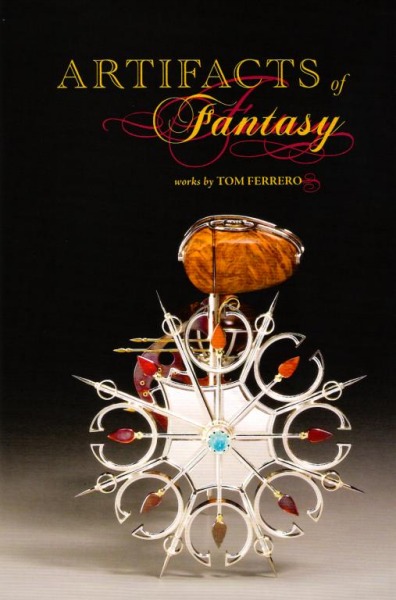Knives - Artifacts of Fantasy
As a species, we have explored nearly every region of our planet and have drawn back the veil concealing the workings of our solar system. In doing so we have left our imaginations to forage the theoretical domains of human understanding, nesting in the deepest depths of our oceans and roving the vastness of our universe. This work entertains the "what if," celebrates the areas unexplored, and contemplates the cultures existing in these realms. Items and subjects such as architecture, maps, ornate objects, fantasy art, and space exploration all interest me for their ability to transport us beyond our experience yet not beyond our human comprehension. Artifacts of Fantasy investigates the possibility of unknown civilizations through the discovery of their implements. The work becomes a preliminary guide and introduction to these cultures, providing us with evidence with which to formulate our ideas. The work specifically focuses on the "knives" these societies use. The knife is of particular interest because of its commonality in all cultures and for its multiple associations that of weapon, tool and ceremonial object. Artifacts of Fantasy examines our understanding of what defines a knife. What purposes do knives have? And who might the users be? I ask the audience to suspend their awareness that these pieces were made by a human artist and entertain the possibility that they are small fragments of real yet unexplained civilizations! *Collectors of fine art, please call or email me for a price list of this collection. A complimentary copy of the exhibition catalog is available upon request. Digging Deeper... According to Dictionary.com the word "Artifact" is defined as: 1. A handmade object, as a tool, or the remains of one... characteristic of an earlier time or cultural stage. 2. Any... object reflecting contemporary society or popular culture. The unknown, and particularly, the possibilities that lie within it have always fascinated me; that metaphorical region just over the horizon where wondrous things may exist. The cutting implements that make up this series each have a function and tell a story about a place, culture and creature (be it human or other). Looking at these artifacts we can extrapolate meanings and uses for these "knives," yet our ideas will always be speculation. I chose the knife format when designing this body of work for two reasons; first, a knife (or sharpened blade) carries with it certain associations. It can be used as a cutting implement for food or as a working tool in the factory or field. It can also be used as a weapon, always harboring an underlying sense of aggression, or it can be used strictly as a ceremonial object. And second, I believe knife like objects would be common across cultures and biological divides. Whether it human or alien, I cannot conceive of a civilization that would not have the need at some point to divide a single unit of something into separate parts. While I am creating knives, instruments that started with a functional purpose, it is not important to me that my finished artworks remain functional (at least not in their ability to cut through a material and maintain their sharpness). However, the allusion of function and their appearance of having been designed for a very specific task is important in making the connection to the knives' culture of origin. This body of work is formally bound together by six concepts and design principles. 1) To create unity and balance through the repetition of shape, color and texture. 2) To utilize contrast of form, color, textures and ideas to create interest. 3) To create a sense of awe through the crafting of visually rich, culturally significant and monetarily valuable objects. 4) To establish a mood for each piece by placing it in a location, attaching it to a culture and/or providing it with a color palette. 5) To appeal to people with and without artistic training, from the very young to older adults. And finally, 6) To employ the design principal of "Horror Vacui" which, derived from the Latin translation literally means, "fear of empty space," and address every component of the artwork with ornamentation or other design elements then unify it with the whole design. One question that sometimes gets raised is whether or not the knife's connection to the human anatomy is important if its' intention is to be used by a non-human species? While I could create objects that accommodate different biologies these pieces are still designed to be read by a human audience and the human imagination. This is not to say our imaginations are weak but rather a more personal relationship can be forged with the objects if the audience can envision how they might hold and use them. Dictated by design and definition, knives traditionally are more two-dimensional forms, consisting of a flat, sharpened blade for cutting and a handle. My intention was to move past this two-dimensional stereotype and intensify the three-dimensional characteristics while still maintaining an identifiable "knife-like" anatomy. The knife may have an unusual arrangement of handle to blade. It may incorporate multiple blades or it may utilize precious materials or the abundant use of decoration in an otherwise utilitarian object. Traditional metalworking techniques and ornamentation connect my work to the past while the use of science fiction and fantasy themes and the knives' connection to popular culture and film places the work in a contemporary context. The adherence to traditional knife making techniques is less important than trying to create forms that push the idea of what a knife can be. (Photo credit: Kevin Montague, except gallery shot). |

